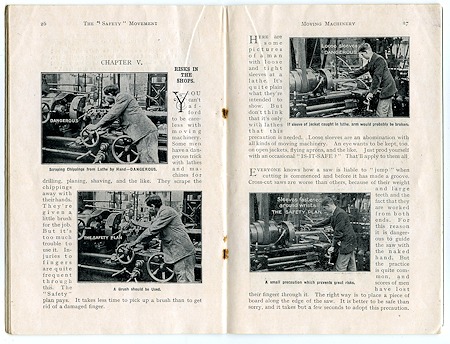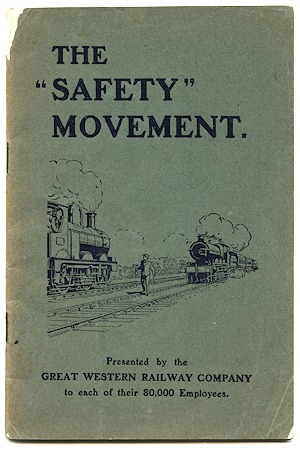 |
|
| News About Us Membership Events Links |
|
|
The 'Safety' Movement
In August 1913 the Great Western Railway Company (GWR) introduced Britain's first dedicated 'modern' safety education campaign, aimed at its employees. Initially comprising articles in the GWR's company magazine, the first 10 articles were gathered together and expanded in this June 1914 booklet. Before this campaign - one hundred years old this month - attempts to improve safety at work made use of rules and regulations and warning notices, phrased in stern, official language. However, safety education tried something new: it made use of diverse techniques and attempted to persuade people to change their behaviour and act safely. It was reliant upon showing people what to do - or what not to do - via photographs and illustrations, combined with informal, conversational language. The GWR's campaign, including this booklet, was a radical change and went on to have a vast impact across British society. As the booklet was aimed at a specific group of people - railway workers - it was reliant upon shared understandings. The front cover demonstrates this nicely: the precise scenario would have been well known by many railway workers, but might not be immediately clear to us. The worker, who would have been maintaining the track, is shown stepping out of the way of one train, but without having checked to see that nothing is on the other track is in danger of being hit by a second train. Track workers were particularly vulnerable to this kind of incident - which was often fatal - as they worked in amongst moving trains, and the noise from one train could mask that of another. A significant detail is noted at the bottom of the front cover - this booklet was given, without charge, to each of the GWR's 80,000 employees. This was intended to indicate the seriousness that the Company accorded to safety matters. 
Click image to read large version The inside pages covered dangers that a large variety of manual workers might have encountered when driving railway engines, cleaning carriages, working on the track, shunting (moving railway goods wagons and carriages), and operating machinery in the railway workshops, amongst others. This final case is shown in the second image, a double-page spread. In 1914 most of the railway companies manufactured virtually everything they used in company-owned workshops, employing a sizeable number of people in what were effectively factories. This image deals with the perils of using moving machinery, particularly catching body parts in the motion. It neatly shows the pairing of incorrect and correct images, complete with helpful arrows and explanations inserted into the images as part of the post-production process. The language used is distinctly informal, as if trying to strike a friendly tone to make the message more palatable. Unfortunately nothing is known about the owner of this booklet, or their response to it. What did they make of the booklet when they received it? How did they respond to the GWR's management telling them how to do their job? Did the booklet have any effect on their behaviour? Why did they keep the booklet? These are just some of the questions I would like answered but doubt I shall ever know for certain. From this starting point, safety education spread throughout the railway industry (where it is still used to this day). It also appeared in other workplaces - initially heavy industries, like manufacturing and mining, but also in office work. At the same time, it spread into road safety, in particular, and later into home safety. Safety messages were to be found on a huge variety of ephemeral items: posters, leaflets, booklets, films, cigarette cards, items of clothing, drip mats for drinks, stickers, card games, matchbox labels, milk bottle tops - even on bars of soap! It was produced by a range of groups: private employers, voluntary organisations (including the Royal Society for the Prevention of Accidents, still around today) and, in the years after the Second World War, the state - largely through the now-defunct Central Office of Information, responsible for campaigns such as the iconic Green Cross Code public information films, but closed down in 2012. This booklet is one of the items that I have used in my research into safety and accident prevention in modern Britain, which has been funded by the Arts and Humanities Research Council and is now based at the University of Portsmouth. Mike Esbester (mike.esbester[at]port.ac.uk)
|
This regular feature shows special items from members’ own collections. Submissions by email should include a scan of the item. |
|
Home | News | About Us | Membership | Events | Links | Contact | Item of the month | Articles |
| Copyright © The Ephemera Society 2024. All Rights Reserved. |
